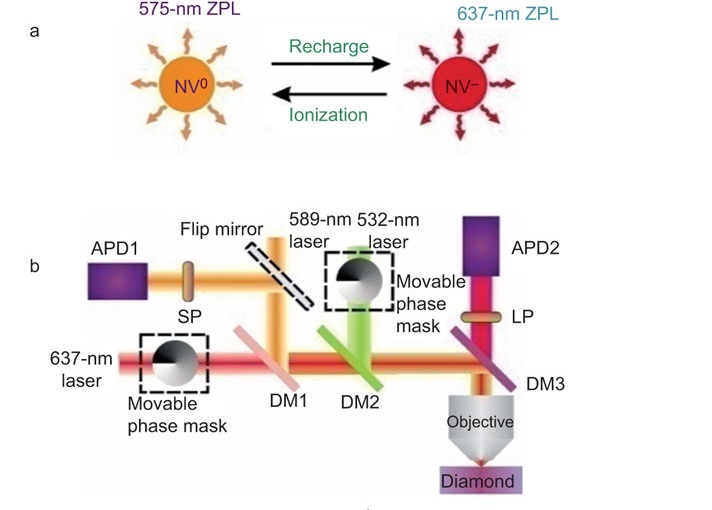SUN Fangwen and his team from Key Lab of Quantum Information and Synergetic Innovation Center of Quantum Information and Quantum Physics of USTC achieved subdiffraction charge-state manipulation on nitrogen vacancy (NV) center in diamond, a potential candidate for quantum computation and metrology. The research published on Jan 2nd on the Light entitled with “
Subdiffraction optical manipulation of the charge state of nitrogen vacancy center in diamond”.

(a) A sketch depicting the charge-state conversion between NV− and NV0. (b) Schematics of the experimental configuration. The lasers and fluorescence emission were combined and split using DM1 (edge wavelength 605 nm), DM2 (edge wavelength 536.8 nm) and DM3 (edge wavelength 658.8 nm). The fluorescence of NV− was detected by APD2 with a long-pass filter (LP, edge wavelength 668.9 nm), and the fluorescence of NV0 was detected by APD 1 with a short-pass filter (SP, edge wavelength 599 nm). Two phase masks were used to produce the doughnut-shaped laser beams. The 637-nm and 532-nm lasers were used to initialize or switch the charge state, and the 589-nm laser is for the detection of the charge state.
"Over the past decade, the negatively charged nitrogen vacancy (NV−) center in diamond has been studied extensively because of the stable fluorescence and long coherence time of its spin state. To further extend the study of the interaction between a multi-NV center and the nanoscale sensing with the NV center, it is necessary to detect and control the NV center spin-state dynamics with high spatial resolution,” SUN said.
They told that many optical super-resolution microscopy techniques have been developed to detect single NV centers, among which stimulated emission depletion (STED) microscopy is one of the most promising.
They demonstrated subdiffraction charge-state manipulation of the NV centers in diamond, and used Laser beams with different wavelengths and shapes to control and detect the charge state, reaching in their experiment the best spatial resolution approximately 4.1 nm.
Using the charge-state depletion (CSD) microscopy, they measured the resonance signal and coherent dynamics of a NV center spin state with subdiffraction spatial resolution, which will be potentially used for nanoscale sensing.
"In the future, we expect that high-resolution NV charge-state manipulation could help to control the spin-state dynamics of NVs and to switch interactions between NV centers,” SUN added.
(GAO Kui, USTC News)